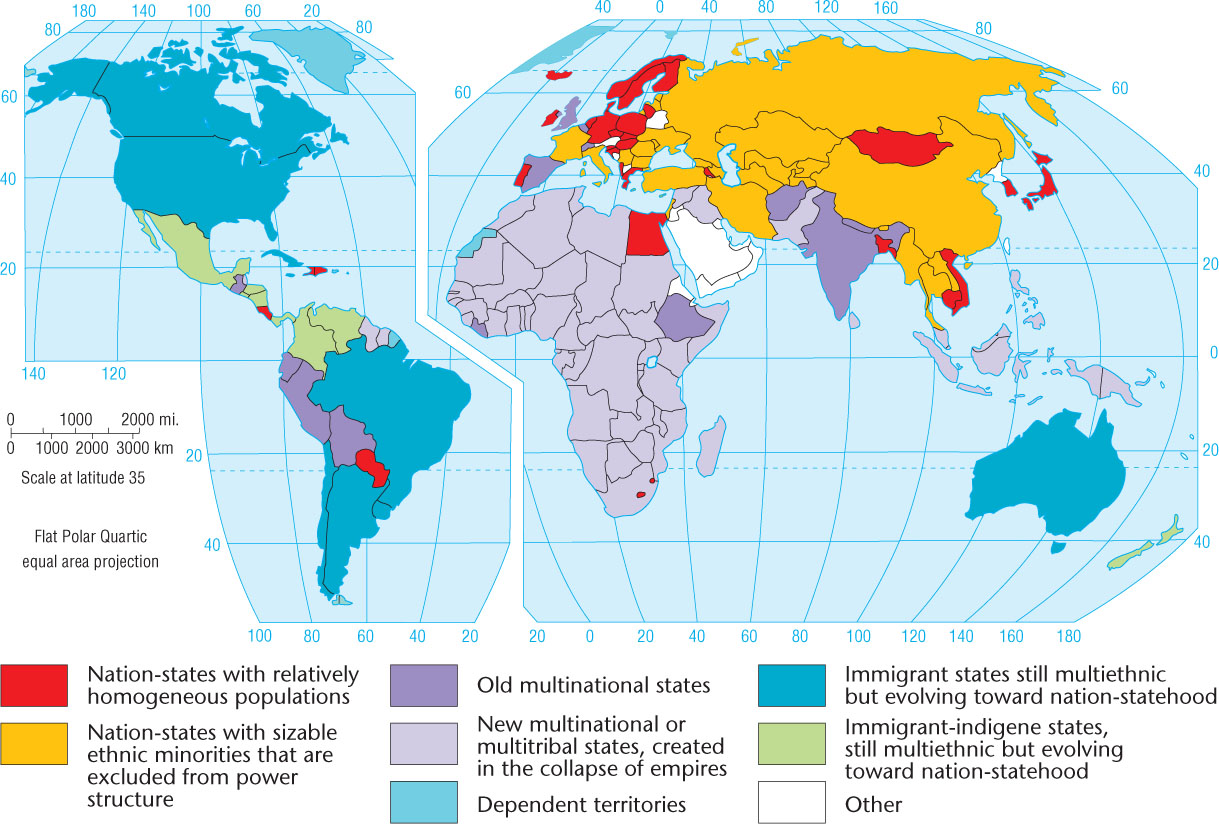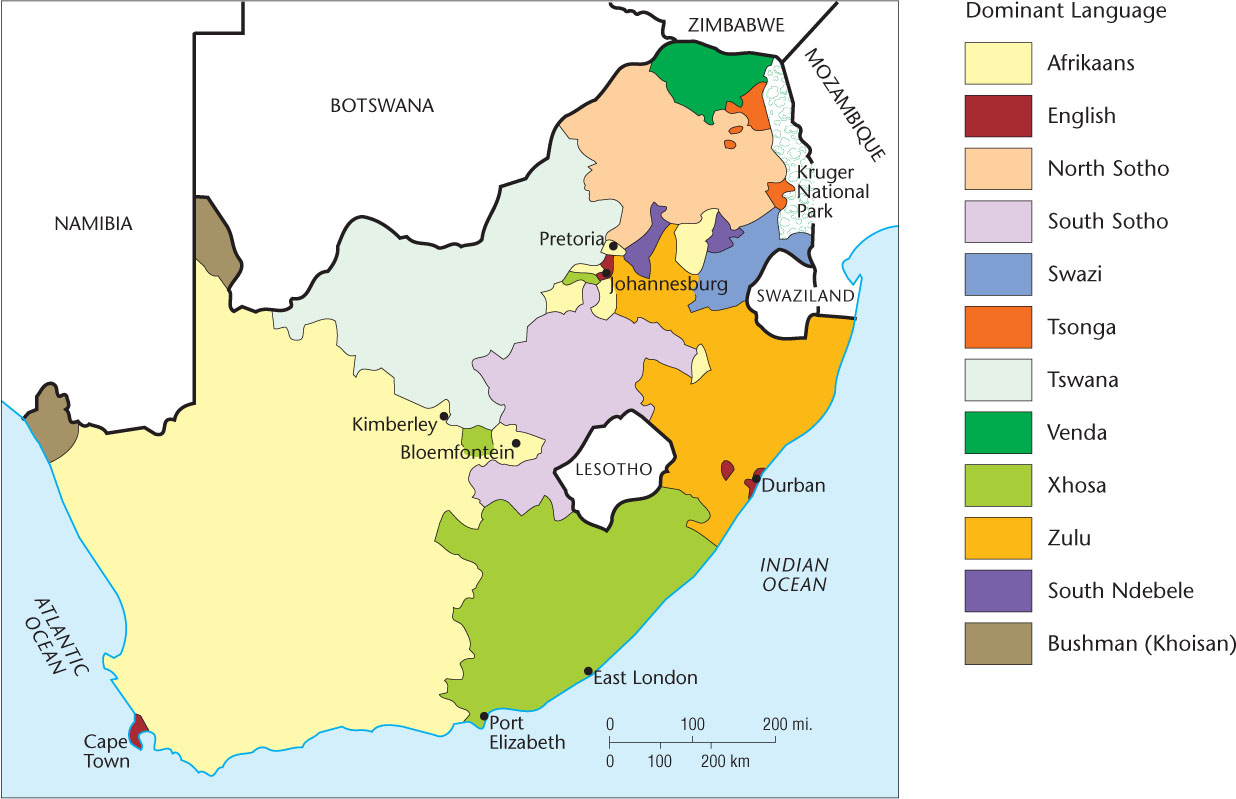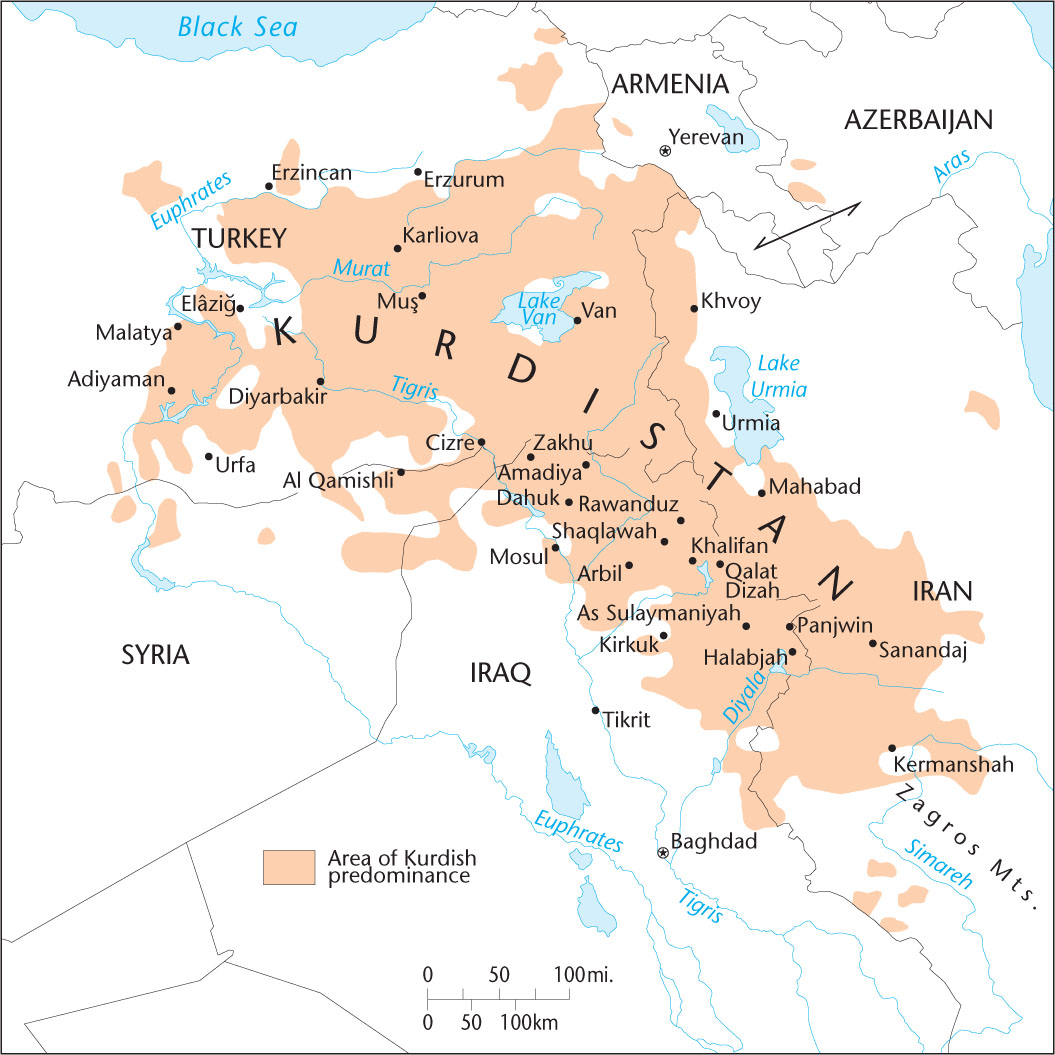Political-Cultural Interaction
Political-Cultural Interaction

How are politics intertwined with the other diverse aspects of culture? Although we learn a great deal from studying how the physical environment and political phenomena interact, we gain an even broader perspective by examining the ties between politics and culture. The growth of independent countries, voting patterns, and other topics that interest political geographers are largely explained in cultural terms. In addition, political decisions often have far-reaching effects on the distribution of such cultural elements as economy, land use, and migration. Indeed, the political organization of territory, both past and present, is revealed to some degree in almost every facet of culture.
6.0.11 The Nation-State
The Nation-State
nation-state An independent country dominated by a relatively homogeneous culture group.
The link between political and cultural patterns is epitomized by the nation-state, created when a nation—a people of common heritage, memories, myths, homeland, and culture; speaking the same language; and/or sharing a particular religious faith—achieves independence as a separate country. Nationality is culturally based in the nation-state, and the country’s raison d’être lies in that cultural identity. The more the people have in common culturally, the more stable and potent is the resultant nationalism. Examples of modern nation-states include Germany, Sweden, Japan, Greece, Armenia, and Finland (Figure 6.17).

Thinking Geographically
Question 6.18
How would you change the classification, and why?
169
Scholars generally trace the nation-state model to Europe and the European settler colonies in the Americas of the late eighteenth century. Political philosophers of the time argued that self-determination—the freedom to rule one’s own country—was a fundamental right of all peoples. The ideal of self-determination spread, and over the course of the nineteenth century, a globalized system of nearly 100 nation-states emerged. Many of these nation-states, such as Portugal, Holland, and France, ruled overseas territories as colonies of the mother country. Under the European Empire, self-determination did not apply to colonies. However, the United Nations incorporated the principle of national self-determination in its charter in 1945. This principle was adopted by independence movements in European colonies around the globe and led ultimately to decolonization.
6.0.12 Ethnic Separatism
Ethnic Separatism
Many independent countries—the large majority, in fact—are not nation-states but instead contain multiple national, ethnic, and religious groups within their boundaries. India, Spain, and South Africa provide examples of older multiethnic countries. Figure 6.18 illustrates this point by dividing up South Africa linguistically.

Thinking Geographically
Question 6.19
How might the complexity of languages have played a role in the delay of majority rule in South Africa?
Many, though not all, multiethnic countries came into being in the second half of the twentieth century. These were former colonies in Africa, South Asia, and Southeast Asia whose boundaries were a product of colonialism. European colonial powers drew political boundaries without regard to the territories of indigenous ethnic or tribal groups. These boundaries remained in place when the countries gained the right of self-determination. Although these states are often culturally diverse, they are sometimes plagued by internal ethnic conflict. What’s more, members of a single, territorially homogeneous ethnic group may find themselves divided among different states by culturally arbitrary international borders.
Many independent countries function as nation-states because the political power rests in the hands of a dominant, nationalistic cultural group, whereas sizable ethnic minority groups reside in the national territory as second-class citizens. This creates a centrifugal force disrupting the country’s unity. Many of the newest nation-states carved out of the former Soviet Union and Yugoslavia, such as Estonia, Armenia, and Serbia, are relatively linguistically and ethnically homogeneous. These states’ cultural homogeneity represents a centripetal force that supports national unity.
170
Those who inhabit ethnic homelands (see chapter 5) often seek greater autonomy or even full independence as nation-states. Even some old and traditionally stable multinational countries have felt the effects of separatist movements, including Canada and the United Kingdom. Certain other countries discarded the unitary form of government and adopted an ethnic-based federalism, in the hopes of preserving the territorial boundaries of the state. The expression of ethnic nationalism ranges from public displays of cultural identity to organized protests and armed insurgencies. Often the ethnic group or political party in control of the country’s military responds with forced deportations and even attempted genocides (as in Rwanda in 1994). Occasionally, successful secessions occur, resulting in the birth of a new nation-state.
Francophones in Canada represent a cultural-linguistic minority group seeking secession. Approximately 10.4 million French-Canadians, concentrated in the province of Québec, form a large part of that country’s total population of 34.8 million. Descended from French colonists who immigrated in the 1600s and 1700s, these Canadians lived under English or Anglo-Canadian rule and domination from 1760 until well into the twentieth century. Even the provincial government of Québec long remained in the hands of the English. A political awakening eventually allowed the French to gain control of their own homeland province, and as a result Québec differs in many respects from the rest of Canada. The laws of Québec retain a predominantly French influence, whereas the remainder of Canada adheres to English common law. French is the primary language of Québec and is heavily favored over English in provincial law, education, and government. In several elections, a sizable minority among the French-speaking population favored independence for Québec, and many Anglo-Canadians emigrated from the province. In 1995, more than half of the French-speaking electorate voted for independence, but the non-French minority in the province tipped the vote narrowly in favor of continued union with Canada. More recently, however, the campaign for independence seems to have weakened.
Reflecting on Geography
Question 6.20
Should Canada split into two independent countries? What would be the advantages and disadvantages for an independent Québec if this split occurred?
171
6.0.13 The Cleavage Model
The Cleavage Model
cleavage model A political-geographic model suggesting that persistent regional patterns in voting behavior, sometimes leading to separatism, can usually be explained in terms of tensions pitting urban against rural, core against periphery, capitalists against workers, and power group against minority culture.
Why do so many cultural minorities seek political autonomy or independence? The cleavage model, originally developed by Seymour Martin Lipset and Stein Rokkan to explain voting patterns in electoral geography, sheds light on this phenomenon. It proposes to explain persistent regional patterns in voting behavior (which, in extreme cases, can presage separatism) in terms of tensions pitting the national core area against peripheral districts, urban against rural, capitalists against workers, and the dominant culture against minority ethnic cultures. Frequently, these tensions coincide geographically: an urban core area monopolizes wealth and cultural and political power while ethnic minorities, excluded from the power structure, reside in peripheral, largely rural, and less-affluent areas.
The great majority of ethnic separatist movements shown, particularly those that have moved beyond unrest to violence or secession, are composed of peoples living in national peripheries, away from the core area of the country. Every republic that seceded from the defunct Russian-dominated Soviet Union lay on the borders of that former country. Similarly, the Slovenes and Croats, who withdrew from the former Yugoslavia, occupied border territories peripheral to Serbia, which contained the former national capital of Belgrade. Kurdistan is made up of the peripheral areas of Iraq, Iran, Syria, and Turkey—the countries that currently rule the Kurdish lands (Figure 6.19). Slovakia, long poorer and more rural than Czechia (The Czech Republic) and remote from the center of power at Prague, became another secessionist ethnic periphery. In a few cases, the secessionist peripheries were actually more prosperous than the political core area, and the separatists resented the confiscation of their taxes to support the less affluent core. Slovenia and Croatia both occupied such a position in the former Yugoslavia.

Thinking Geographically
Question 6.21
What might cause so large and populous a nation to fail to achieve independence?
172
By distributing power, a federalist government reduces such core-periphery tensions and decreases the appeal of separatist movements. Switzerland, which epitomizes such a country, has been able to join Germans, French, Italians, and speakers of Raeto-Romansh into a single, stable independent country. Canada developed under Francophone pressure toward a Swiss-type system, extending considerable self-rule privileges even to the Inuit and Native American groups of the north. Russia, too, has adopted a more federalist structure to accommodate the demands of ethnic minorities, and 31 ethnic republics within Russia have achieved considerable autonomy. One of these, Chechnya (called Ichkeria by its inhabitants), has been fighting for independence.
6.0.14 Political Imprint on Economic Geography
Political Imprint on Economic Geography
The core-periphery economic differences implicit in the cleavage model reveal that the internal spatial arrangement of an independent country influences economic patterns, presenting a cultural interaction of politics and the economy. Moreover, laws differ from one country to another, which affects economic land use. As a result, political boundaries can take on an economic character as well.
For example, many international borders within Europe correspond to noticeable variations on the economic landscape resulting from differences in laws regarding nuclear energy development. Some European states, such as France and the United Kingdom, believe nuclear power is the best way to alleviate dependence on foreign oil. In contrast, countries such as Norway and Ireland have refrained from developing nuclear energy facilities within their borders due largely to environmental concerns. Some European states that have developed nuclear energy facilities in the past, such as Germany and Spain, have committed themselves to phasing out nuclear power over the coming years because of these same environmental concerns. At present, however, the mosaic of nuclear energy production across European political boundaries clearly illustrates the ongoing interplay between politics and the economic landscape.
Reflecting on Geography
Question 6.22
How might political decisions regarding the economics of nuclear energy production in one country impact land-use decisions in neighboring countries that have chosen not to develop nuclear energy production?